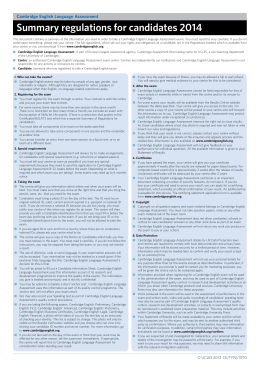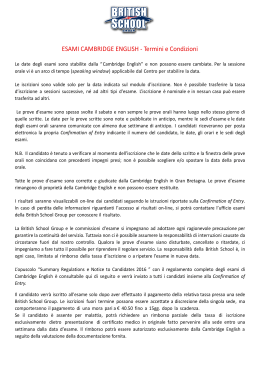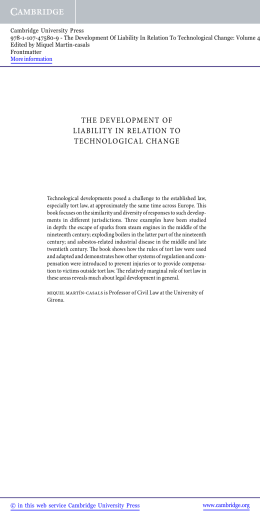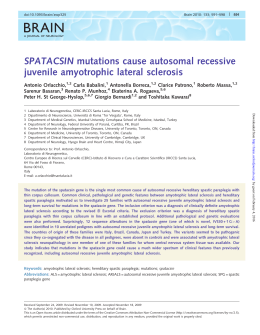Mathematical Proceedings of the Cambridge Philosophical Society
http://journals.cambridge.org/PSP
Additional services for Mathematical Proceedings of the Cambridge Philosophical Society:
Email alerts: Click here
Subscriptions: Click here
Commercial reprints: Click here
Terms of use : Click here
Discussion of Probability Relations between Separated Systems
E. Schrödinger
Mathematical Proceedings of the Cambridge Philosophical Society / Volume 31 / Issue 04 / October 1935, pp 555 563
DOI: 10.1017/S0305004100013554, Published online: 24 October 2008
Link to this article: http://journals.cambridge.org/abstract_S0305004100013554
How to cite this article:
E. Schrödinger (1935). Discussion of Probability Relations between Separated Systems. Mathematical Proceedings of the Cambridge Philosophical Society, 31, pp 555563 doi:10.1017/S0305004100013554
Request Permissions : Click here
Downloaded from http://journals.cambridge.org/PSP, IP address: 128.103.149.52 on 10 Aug 2013
555
DISCUSSION OF PROBABILITY RELATIONS BETWEEN
SEPARATED SYSTEMS
BY E. SCHRODINGER
[Communicated by Mr M. BORN]
[Received 14 August, read 28 October 1935]
1. When two systems, of which we know the states by their respective representatives, enter into temporary physical interaction due to knownforces between
them, and when after a time of mutual influence the systems separate again, then
they can no longer be described in the same way as before, viz. by endowing each
of them with a representative of its own. I would not call that one but rather the
characteristic trait of quantum mechanics," the one that enforces its entire
departure from classical lines of thought. By the interaction the two representatives (or ^-functions) have become entangled. To disentangle them we must
gather further information by experiment, although we knew as much as anybody could possibly know about all that happened. Of either system, taken
separately, all previous knowledge may be entirely lost, leaving us but one
privilege: to restrict the experiments to one only of the two systems. After reestablishing one representative by observation, the other one can be inferred
simultaneously. In what follows the whole of this procedure will be called the
disentanglement. Its sinister importance is due to its being involved in every
measuring process and therefore forming the basis of the quantum theory of
measurement, threatening us thereby with at least a regressus in infinitum, since
it will be noticed that the procedure itself involves measurement.
Another way of expressing the peculiar situation is: the best possible knowledge
of a whole does not necessarily include the best possible knowledge of all its parts,
even though they may be entirely separated and therefore virtually capable of
being " best possibly known ", i.e. of possessing, each of them, a representative of
its own. The lack of knowledge is by no means due to the interaction being insufficiently known—at least not in the way that it could possibly be known more
completely—it is due to the interaction itself.
Attention has recently* been called to the obvious but very disconcerting fact
that even though we restrict the disentangling measurements to one system, the
representative obtained for the other system is by no means independent of the
particular choice of observations which we select for that purpose and which by
* A. Einstein, B. Podolsky and N. Rosen, Phya. Rev. 47 (1935), 777.
556
E. SCHEODINGER
the way are entirely arbitrary. It is rather discomforting that the theory should
allow a system to be steered or piloted into one or the other type of state at the
experimenter's mercy in spite of his having no access to it. This paper does not
aim at a solution of the paradox, it rather adds to it, if possible. A hint as regards
the presumed obstacle will be found at the end.
2. To begin with I wish to establish a simple theorem, which makes it very
obvious that the phenomenon in question is a quite general one; that it is the
rule and not the exception. The representative arrived at for one system depends
on the programme of observations to be taken with the other one. It is necessary
to envisage the dependence on the programme. For since one device only can be
carried out in every individual case and since, moreover, we cannot tell the result
(because after all we are not actually experimenting, but sitting at our desk),
there seems to be a certain liberty for presuming that perhaps, after all, there is
always or at least in most cases a result possible, which is also possible when other
devices are followed, and that perhaps it is this that actually would turn up.
Let x and y stand for all the coordinates of the first and second systems
respectively and f (x, y) for the normalized representative of the state of the
composed system, when the two have separated again, after the interaction has
taken place. What constitutes the entanglement is that *F is not a product of a
function of x and a function of y. Now suppose that we perform on the second
system certain observations in consequence of which its representative, at the
moment in which disentanglement is reached, is sure to turn up as one out of the
known complete set of normalized orthogonal functions /„ (y). Then, provided
that the variables which we have measured all commute, we have to develop
*F (x, y) into a series with respect to the/ n ,
n
in order to come to know the representative of the other system. When the
readings on the y-system point tofk (y), we have to adopt gk (x) as the representative of the z-system. The ck have been introduced in order to assume that the
gk are normalized, i.e. that
!gt{x)gk(x)dx=l.
(2)
Of course | ck |2 is the probability of that particular case occurring. The equations
(3)
together with (2) determine the c's and the g's, apart from an irrelevant phasefactor in every g and its reciprocal in the corresponding c and apart from the
possible indeterminateness of g, should the integral for some values of k vanish
identically in x.
Probability relations between separated systems
557
There is no reason for the gk to be orthogonal to each other. Let us ask when
they are, i.e. how must the/fc be chosen for that purpose ? The condition evidently is
4 c,3w=jdx jdyjdy'fk (y') Y* (x, y')f* (y) Y (x, y).
(4)
This amounts to saying that, for every k, the function
% (V) = jdx jdy'fk (y') Y* (x, y') Y (x, y)
(5)
is to be orthogonal to all the ft(y), with the possible exception offk(y). Hence
uk (y) must be a numerical multiple of fk (y). From (4), with I = k, it is seen that
the numerical multiplier is | ck |2. We have therefore
I ck |V* (y) =jdx jdy'fk (y1) Y* (x,f) Y (x, y).
Introducing the function
K (y, y') = [dx Y* (x, y')Y(x,y),
(6)
(7)
which has Hermitian symmetry, we see from (6) that the reciprocals of the
| ck | 2 and the functions fk (y) are required to be the eigenvalues and a system of
eigenfunctions respectively of the homogeneous integral equation
= xJK(y,y')f(y')dy'.
(8)
Provided that the integral in (7) converges, so that K is defined, a complete
solution of (8) exists. (It is convenient for our purposes, in order to be concerned
with complete sets only, to include the functions, orthogonal to K, as eigenfunctions belonging to A = oo, at variance with the custom of mathematicians.)
By using this set for the development (1) one easily satisfies oneself that all
requirements are fulfilled, in particular that the Aj^1 are all non-negative and
that their sum is unity.
The general case is evidently that all the A^"1 are different from one another,
except maybe for an arbitrary set of them vanishing. Then the relevant fk (y) are
uniquely determined and so are the gk (x). Hence there is always one and as a rule
only one development of Y (x, y) of the type which might suitably be called
"biorthogonalf"
Whenever (and of course only when) the eigenfunctions of a programme to be
carried out on the y-system include the relevant functions fk (y), or the eigenfunctions properly speaking of (8), the programme will lead to the biorthogonal
development and imply the relevant gk (x) as the other set. Now if for an arbit The whole mathematical treatment is familiar to mathematicians in dealing with an
"unsymmetrical kernel" xY(x,y). See Courant-Hilbert, Methoden der mathematischen
Physik, 2nd edition, p. 134.
558
E . SCHBODINGER
trarily fixed programme of measurements on the ^-system the representative
arrived at for the x-system was the same in all individual cases, the same gk (x)
would have to turn up (and even with the same probabilities) as in the biorthogonal
development; for in two infinite series of repetitions ab ovo of one and of the
other programme respectively every possible result occurs according to its due
probability-. Hence the relevant functions gk (x) would have to be implied whatever programme is carried out. But since, of course, they also determine the
biorthogonal development uniquely and thereby require the relevant fk (y) as the
other set, these would have to be included in the eigenf unctions of every programme
which cannot be, since the latter are, by principle, an entirely arbitrary complete
orthogonal set. Hence tne non-invariance is proved*.
There must, of course, be cases in which the biorthogonal development refers
to a continuous variable (or set of commuting variables), an integral replacing
the series (1); and also mixed cases. In our present treatment they would be
indicated by the integral (7) diverging and would therefore require a separate
treatment, on which I shall not enter here.
The biorthogonal development is the one to give us true insight into the entanglement. If there are no coincidences among the \ck\2 (excluding also the
case, that more than one of them vanish) the relevant/ & 's form a well-determined
and complete set and so do the gk's. Then one can say that the entanglement
consists in that one and only one observable (or set of commuting observables)
of one system is uniquely determined by a definite observable (or set of commuting observables) of the other system. This is the general case. We shall now
turn to the opposite extreme, which is the Einstein-Podolsky-Rosen case. It
could be characterized by all the | ck | 2 being equal and all possible developments
being biorthogonal. Every observable (or set, etc.) of one system is determined
by an observable (or set, etc.) of the other one. But the mere fact, that the equality
of the | ck | 2 prevents their sum from being normalized to unity, shows us that very
improper representatives (in fact much more so than Dirac's 8, 8', 8", ...) are
involved in this case, making it advisable to deal with it on slightly different lines.
.3. For simplicity's sake we suppose each of the two systems to have one
degree of freedom only. Let the ^-numbers xr, p1 and x2, p2 denote coordinate
and momentum of the first and of the second system respectively. The existence
of further degrees of freedom would not affect the considerations of this section
except for slight alterations in the wording; but for section 4 to hold it would have
to be assumed, that within each of the two systems the degree of freedom which
we investigate has its Hamiltonian separated from the rest.
* In order to adapt this proof to the case when the biorthogonal development is not
unique, just replace the biorthogonal development by a particular one, on which you fix
your attention.
Probability relations between separated systems
559
The two systems are of course supposed not to interact with each other. The
entanglement is to be such that the two commuting observables
x = x1-x2,
p=Pi+p2,
(9)
which we choose to represent the state of the composed system, have definite
numerical values, say x' and^>' respectively, which we suppose to be known. The
representative T of the composed system is a function of the eigenvalues of x and
p, which involves x' and p' as parameters and vanishes everywhere except in that
point where the former are equal to the latter. It is not a 8-function though and
can hardly be written explicitly. According to our assumptions Y must have the
properties
xy¥ = x'y¥ and px¥=p'x¥.
(10)
We shall use no others.
From (9) the variable x can be observed by observing x1 and x2 separately,
because the latter commute. The difference of the observed values, x[ and x'2 say,
must be equal to x':
x' —x' =x'
(11)
Hence x'x can be predicted from x'2 and vice versa. Similarly
Pi+P%=P'.
(12)
so that the result of measuring px serves to predict the result for p% and vice versa.
But of course every one of the four observations in question, when actually performed, disentangles the systems, furnishing each of them with an independent
representative of its own. A second observation, whatever it is and on whichever
system it is executed, produces no further change in the representative of the
other system.
Yet since I can predict either x'xorp\ without interfering with system No. 1 and
since system No. 1, like a scholar in examination, cannot possibly know which of
the two questions I am going to ask it first: it so seems that our scholar is prepared
to give the right answer to the first question he is asked, anyhow. Therefore he
must know both answers; which is an amazing knowledge, quite irrespective of
the fact that after having given his first answer our scholar is invariably so
disconcerted or tired out, that all the following answers are "wrong"
Thus far the results of the paper quoted above. Now I wish to point out that
system No. 1 (say) has further knowledge. It does not only know these two
answers but a vast number of others, and that with no mnemotechnical help
whatsoever, at least with none that we know of.
Let us consider an Hermitian operator referring to the first system and given
as a "well-ordered" analytic function of the observables xx a n d ^ :
F{x1,p1),
(13)
which we suppose not to contain the y/ — 1 explicitly. It is an observable of system
No. 1. We shall prove that its value is equal to the value of the following observ(14)
able of system No. 2
F(xi + x',p'-p2),
560
E. SCHBODINGER
so that the result of either observation can be predicted from the other one. That
is not trivial, because the equations x = x' a,nd p=p' do not hold, except in the
form (10), that is to say they are not identities.
The proof will be produced, if we can show that the difference of the two
operators, when applied to T , gives zero:
{*I(*a + *',p'-j»,)-J I (a; 1> .p 1 )}Y = 0.
(15)
.Using (9), we may write this in the form
{F(xl + x'-x,p1+p'-p)-F(x1,Pl)}*¥
= 0.
(16)
To prove it we observe that any operator which ends on its right with a factor
x' — x orp' —p reduces W to zero, from (10). Additive terms of this type can therefore be dropped within the curved bracket. Nowfixthe attention on one of the
power products in the minuendus. Its last factor, either x1 + x' — x or px-+p' —p,
can be replaced by xx or p±, as the case may be, and then this xx or p1 commutes
with the rest of the power product and can be removed to its extreme left. The
second step consists in applying a similar treatment to the factor (x1 + x' — x or
Pi+p'—p, as the case may be), which has now become the last; but this one
cannot safely be displaced to the extreme left but only to the second place, counting
from the left. This procedure is continued until we are left with a power product
which differs from the original one in that x1 and p1 have replaced xx + x' — x and
Pi+p' —p respectively and also that the order of factors has been reversed. But
F, owing to its Hermiticity and to the further condition that it shouldnot contain
V —1 explicitly, must contain the "reversed" power product too. Hence after
applying the same treatment to all of them, we are left with F(xt,p1), which
cancels with the subtrahendus, and the statement is proved.
If F contains the y/ — 1 explicitly, we could replace it by {x^^—p^x^jh. Then
the prescription (14) would apply without corollary. It would turn the operator
just mentioned into {p%x2 — x2p2)lh which now can be replaced by — \ / — 1 .
From this follows the corollary to prescription (14), that an explicit y/ — 1 has to
change sign.
By this theorem all observables are placed on the same footing. Our system,
in its virgin state, must know the answers to all of them. One might presume that
it avails itself at least of a suggestive mnemotechnical device, viz. that the answer
prepared for the variable F(x1,p1) is simply F(x'1,p'1), if x[ and p[ are those
prepared for x1 and pt respectively. But this is not so. For consider, e.g., the
series of observables
i
•F («!.!>!, &) = £i>!+ 6*1,
where 6 is to be a positive c-number parameter. With every value for b we are
confronted with a new observable, to which an answer must be pending. Moreover the answer must be, irrespective of b, an odd integral multiple of h (though
Probability relations between separated systems
561
not necessarily independent of 6). This shows plainly that all these answers
cannot conform to the results which would be obtained by inserting into the
expression the same pair of c-numbers, p[ and x[; which, by the way, are simultaneously accessible to experiment in every individual case, one by direct observation, the other one by inlerence from an observation on the other system.
Our complete lack of insight into the relationship between the different
answers in one system is all the more bewildering, since we have proved, on the
other hand, that the one-to-one correspondence between the answers of the two
systems necessarily extends to all pairs of observables whenever it holds for two
of them.
4. If equations (10) are assumed to hold at time zero, the equations of motion
determine what becomes of them as time proceeds. Let the Hamiltonian of the
composed system be
H = H1(zi,p1) + H2(x2,p2)
(17)
and let it not contain the time explicitly. We shall use what Dirac calls a
Heisenberg representation; then every variable at time t is a function of the
variables at time zero, e.g.
itHjh
-UHjh
, 1Q >
x^ = c
x^e
—
V^°J
From prescription (14), including the corollary, we can find out what observable of system No. 2 is equivalent to xu; we call it [xu]2,
(19)
This equation, by its form, indicates the observation on No. 2 at time zero, which
would serve to predict the coordinate of No. 1 at time t. Solving two equations,
similar to (18) for x2 and p2, we get
- UH,lh
itH.,ih
ic\iw
x2 = e _2' xae u
(20)
and similarly for p2. Of course H2 has now to be thought of as written with the
arguments xu and pn\ which does not affect its form, since it is a constant of the
motion. With these expressions replacing x2 and p2 in (19), the exponentials with
H2 cancel in the interior, leaving just one in front and in the rear. So the final
r08
" l t iS
[*„]* = « " '""*"' e " '"fl"'- (*« + *') e"">"' eiUI'/h,
(21)
where / / , and // 2 are precisely the functions of equation (17), but written with the
arguments
Xsl
+ x'
and p'-pa
for Hx,
x a and pn for H2.
This rather complicated function of Xy andpy is that observable of system No. 2
which is equivalent to xu. Though we have deduced it by means of a Heisenberg
representation, the functional connection is of course exactly the same for what
Dirac calls the Schrodinger representatives. That is to say, we can take x^ and
pn to have the general meaning of x2 and p2 of the preceding section. Regarded as
operators they then do not involve the notion of time but work on a 'F-function,
PSP xxxi, 4
37
562
E. SCHBODINGEB
which develops according to the wave equation. This consideration applies to
every moment of time. It is therefore correct to say, that the variable which in
No. 2 is equivalent to the coordinate in No. 1 undergoes a continuous unitary or
contact transformation as time goes on. The transformation is of course the same
for every observable, so that we need not write out the formulae for [pu]2 or for
an arbitrary [F (xlt ,pv)]2 • It is noteworthy that the two exponentials of which the
transformation is composed may not be amalgamated, because H1 and H2,
considering the arguments with which they are written, do not in general
commute.
All this is moderately trivial. But it is necessary to consider it lest one should
believe that the antinomies could be solved by suggesting or proving that some
of the observations must take a certain minimum time. Provided that they
relate to a definite moment, this will not help us. It cannot be argued that, before
the results are reached, the situation to which they refer has passed away.
A prediction for time zero does not dissolve into nought as time goes on, but
simply transforms into the prediction of another observable. And any desired
observable can be predicted for time t by making a suitable observation at time
zero on the other system.
When at time zero a certain observable of system No. 1, say x1, is inferred from
observing x2, I am forced to assign to system No. 1 a representative that makes
the observable x1 precise and tells nothing about its canonically conjugate,
although I safely infer that system No. 1 does know quite a definite (as opposed
to a haphazard) answer for the canonical conjugate as well, the only difference
being that I know the one while I am ignorant of the other. Now this paradoxical situation is not confined to time zero and could not, therefore, be avoided
by my satisfying myself that the result of observing x2 cannot be known before
a certain time has elapsed. From the moment I come to know the result I should
be faced with exactly the same situation, only the pair of canonically conjugate
dbservables that is involved changes with time.
The paradox would be shaken, though, if an observation did not relate to a
definite moment. But this would make the present interpretation of quantum
mechanics meaningless, because at present the objects of its predictions are considered to be the results of measurements for definite moments of time.
My sincerest gratitude is due to Imperial Chemical Industries, Limited, to
whose generosity I owe the leisure for carrying out these studies.
Probability relations between separated systems
563
SUMMARY
The probability relations which can occur between two separated "physical
systems are discussed, on the assumption that their state is known by a representative in common. The two families of observables, relating to the first and
to the second system respectively, are linked by at least one match between two
definite members, one of either family. The word match is short for stating that
the values of the two observables in question determine each other uniquely and
therefore (since the actual labelling is irrelevant) can be taken to be equal. In
general there is but one match, but there can be more. If, in addition to the first
match, there is a second one between canonical conjugates of the first mates, then
there are infinitely many matches, every function of the first canonical pair
matching with the same function of the second canonical pair*. Thus there is a
complete one-to-one correspondence between those two branches (of the two
families of observables) which relate to the two degrees of freedom in question.
If there are no othersf, the one-to-one correspondence persists as time advances,
but the observables of the first system (say) change their mates in the way that
the latter, i.e. the observables of the second system, undergo a certain continuous
contact-transformation.
* To make the earlier text conform to the present simplified wording, replace x2 + x' by
P andp' —p2 by X. Then X and P are canonical conjugates. The mating (ar with P and p"
with X) has to be cross-wise, though.
t In fact it persists anyhow, but as a rule in a very much more complicated form.
37-2
Scarica






